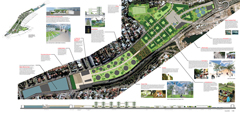White Bay Eco-City 2050
Exhibit Category / Catégorie de l'expo: City
Location/Emplacement: Sydney, NSW, Australia
Dates: 2005
Designers/Concepteurs: Students under the direction of Dr. Rafael Pizarro, University of Sydney, Faculty of Architecture, Design and Planning
Clients: n/a
More Information/Plus d'informations: ecocitylab.org/ecocitydesignstudio/ecocities2050/
Image Credits/Crédits d'images: Dr. Rafael Pizarro
Project Description: (version française ci-dessous)
Recent development in Sydney, Australia has been characterised by a series of large-scale urban projects on brownfield sites. White Bay is one of the last under-developed sites on Sydney Harbour near the central business district. At 80 hectares, bordered by established neighbourhoods, bisected by a major road, in the shadow of the Anzac Bridge, the site presents major challenges for the urban designer.
White Bay Eco City was designed as part of the Open Studio at the University of Sydney, Faculty of Architecture, Design and Planning. The project was a collaboration between twenty senior students and Dr. Rafael Pizarro, the Faculty’s Lecturer in Sustainable Urban Planning. The brief was simple: design a carbon neutral city for 15,000 residents. While the project’s aim was to speculate about how cities would change in response to global warming, the brief also recognised that such prime foreshore land is extremely valuable and that a certain density of development was inevitable.
Transport was the first critical issue. As a major new development near the CBD, the design had an obligation to incorporate infrastructure improvements which would benefit the entire Sydney region. Bicycles and GPS-guided stackable mini-cars developed by MIT’s media lab provide flexible transport options within the site. The street takes on a whole new meaning once traffic is eliminated; “streets” can be narrow or wide, promenades or laneways, lined with canals and trees, merging into parks and plazas. In a zero carbon city, the module of the automobile no longer defines the dimensions of public spaces.
The site divides naturally into five precincts: a CBD, a semi-industrial working harbour district, an institutional hub, a quiet neighbourhood and an area devoted to urban agriculture. Most buildings are mixed use, ranging in height from 12 storeys near the Anzac Bridge to two or three storeys closer to the harbour foreshore. Passive solar design determines built form throughout the Eco City, with orientations towards the sun and narrow floor plates for cross ventilation. Roof gardens alternate with photovoltaic panels to supplement the food and energy produced elsewhere on site. Rainwater is collected for reuse block by block while grey and black water are processed in a large central plant in the agricultural precinct at the southern end of the site.
While most of the site exemplifies the kind of fine-grained mixed use urbanism advocated by Jane Jacobs and others, the agricultural precinct is a uniquely twenty-first century creation. The area incorporates water treatment and food production for the entire site, with surplus for surrounding areas as well. The precinct cleverly uses the natural flow of water to take advantage of a difficult site. At the southern end, an existing canyon is dammed to store runoff from surrounding areas. This water then runs a small hydroelectric turbine to provide energy and is recycled for irrigation in seven vertical farm towers. These vertical farms are a new typology based on current research into urban agriculture and are perhaps the most spectacular manifestation of the Eco City’s self-sufficiency.
Browse for more projects in the Carrot City Index.
Trouvez d’autres projets avec l’Index de Carrot City.



